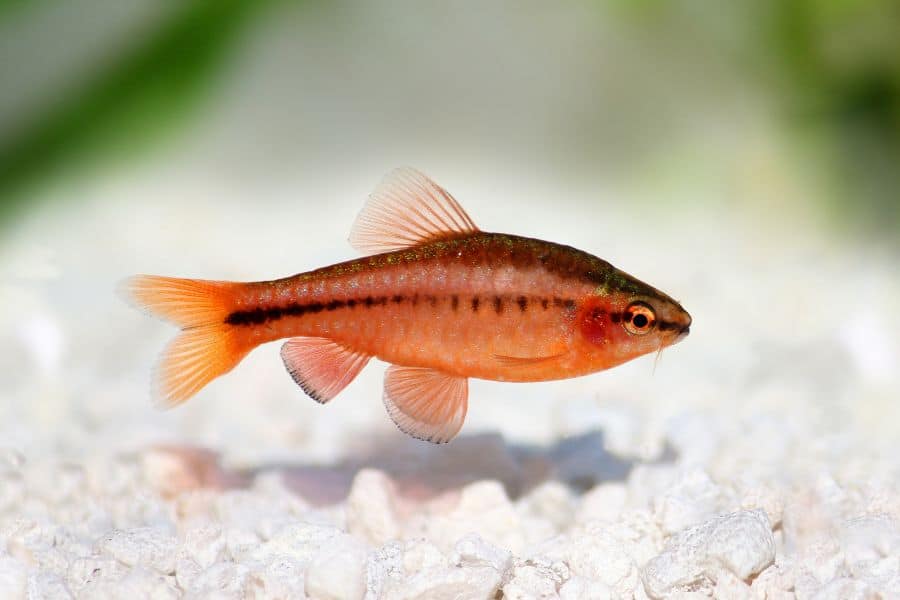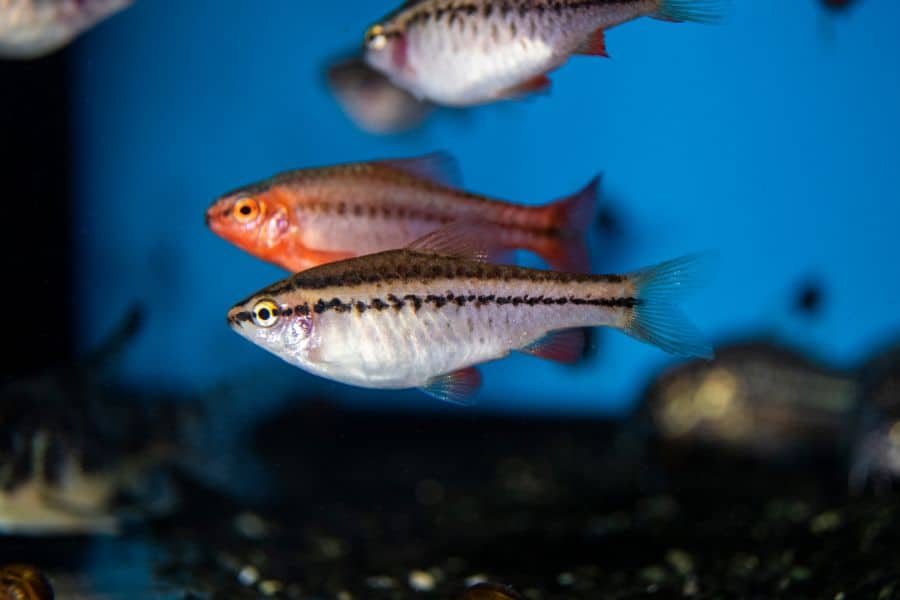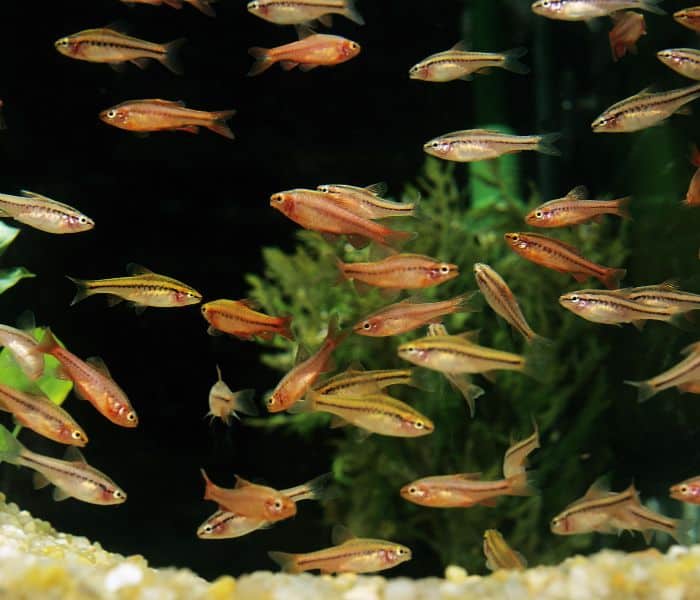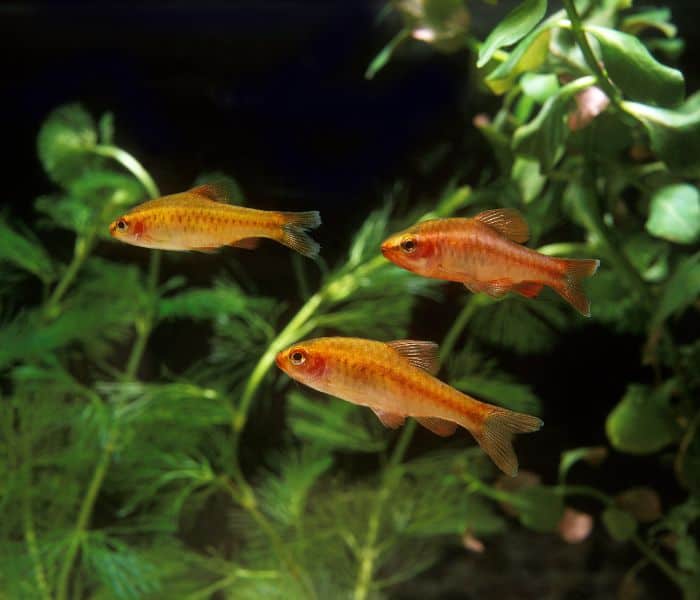Genetically wired to compete for limited resources, Barbs are aggressive in general. It is why most of their species don’t do well in a community tank, and their tank mates may be limited to a few.
However, there is a type of barb that is known for its peaceful behavior and is considered a great buddy to most freshwater aquarium fish.
In this article, learn more about the life of Cherry Barbs, how to grow them, and discover why they are considered the most friendly type of barb.
Cherry Barb Overview
Cherry Barbs (Puntius titteya) are popular freshwater aquarium fish known for their cool temperament and dazzling red color. But aside from this, you should know their biological characteristics to understand the life of this tiny fish.
Sri Lankan Origins
Despite being a small fish, the native habitat of Cherry Barbs is relatively large. They naturally thrive in some of the longest rivers in Sri Lanka, like the 72 km-long Nilwala River and the Kelani Ganga, which extends for 145 kilometers.
In their wild Sri Lankan home, Cherry Barbs thrive in shallow streams with minimal water flow and lots of leaf debris on surface water and in the riverbed.
Omnivorous 2-inch Fish
Considered one of the smallest barb fish, Cherry Barbs can only grow up to 5 cm (2in) long. Although tiny, their food items are limitless.
Cherry Barbs are omnivores. They eat both animals like small insects and plants such as diatoms and green algae. But make no mistake of making them agents in controlling unwanted algae growth since plant matter is only a fraction of their already small appetite.
Red Males and Brown Females
As their name suggests, Cherry Barbs got their name from their rich red color, like a cherry fruit. However, this color description does not apply to both sexes.
The red body coloration is only for the males, while the females are brown. What is common for both sexes is a black horizontal line that runs along the body length. Again, there is a slight difference since the line is more pronounced in males and lighter in females.
Barbels and Their Relation to Carps
Another identifying feature of Cherry Barbs is the barbel. They are a pair of whisker-like sensory organs protruding in their mouth that aids the fish in sensing their surroundings and locating their food.
Barbels are not just a common feature of all barb species. The fact is that all fish under Family Cyprinidae have barbels, making Cherry Barbs and Carps closely related.
Take note that the length of barbels varies per species. In the case of Cherry Barbs, they are relatively small and you need to focus your sight to locate them.
Potentially Vulnerable to Overfishing, Habitat Alteration and Pollution
According to the IUCN Red List of threatened species, Cherry Barbs are vulnerable to extinction. Two main factors threaten Cherry Barbs.
First is overfishing since they are heavily fished out in their wild habitat, but not for food. Instead, with their popularity as freshwater aquarium fish, Cherry Barbs are traded globally with increasing demand.
Alteration of their natural habitat in Sri Lanka is the second factor that threatens Cherry Barbs. It is due to the construction of mega infrastructures like hydroelectric power plants and worsened by the effluents from nearby industries that cause chemical pollution.
Captive Varieties
Despite being vulnerable to extinction, it is not the end for Cherry Barbs, and you will continue to see them in pet shops as they are now widely bred in captivity.
While Pet shops feature the regular red and torpedo-shaped bodies of Cherry Barbs, some fish farms have successfully come up with cross varieties like the Albino and the long fin or Veiltail Cherry Barb.
Cherry Barb Care
Cherry Barbs are hardy, and taking care of them is relatively easy. But this doesn’t mean you just place them in the water and leave them behind.
Like other fish, Cherry Barbs have their growth requirements to be healthy and happy during their entire stay in your aquarium.
25 Gallons for their School
Cherry Barbs are schooling fish. Although they do not swim in a synchronized manner, they still prefer to stay in groups.
Providing them with a tank with enough swimming space (25 gallons minimum) would encourage them to go out and socialize with other fish. Remember that you are setting up a community tank, and the tank space may not be exclusively for your Cherry Barbs.
Stocking Density
Although tiny, it doesn’t mean you will load up your tank with Cherry Barbs. Their ideal stocking density is six fish for every 10 gallons of water. It means that for your 25-gallon aquarium, you can stock anywhere from 12 to 15 Cherry Barbs.
And it’s not just about quantity. Having a variety of sexes will keep their population healthy. Most aquarists keep two females for every male. In your 25-gallon tank, this equates to 8 to 10 females and 4 to 5 males.
Broad Temperature Range
The wild Sri Lankan habitat of Cherry Barbs experiences the monsoon season. In effect, despite being a tropical fish, they can thrive in a broad range of water temperature, anywhere from 22 to 27 C (72 to 80 F), which is one of the widest ranges in the entire Barb family.
Soft, Low Flow and Slightly Acidic Waters
One of the ultimate aims of aquarium keeping is to closely mimic the wild habitat parameters in which our fish originated. With Cherry Barbs, you can easily attain this by decreasing your water flow to a minimum, making your water slightly acidic (6.0 to 7.0 pH) and softer (4 to 10 dGH).
Dim Lighting
Lighting is seldom a requirement in keeping fish. However, we would like to emphasize this since Cherry Barbs specifically require low to moderate light. It is due to the turbid nature of their wild habitat where sunlight penetration is often blocked by silt and leaf litter.
Plants and Hiding Places
To mimic the shade provided by the leaf litter in their wild habitat, keeping Cherry Barbs in a tank requires live aquarium plants.
Specifically, they need floating plants to partly block the light and create a shadowy shade, as well as bottom plants that will become their resting and hiding place.
Summary of Cherry Barb Growth Requirements
| Parameters | Range |
| Minimum Tank Size | 25 gallons |
| Stocking Density | 6 fish / 10 gallons |
| Temperature | 22 to 27 C (72 to 80 F) |
| Water flow | Low |
| pH | 6.0 – 7.0 |
| Hardness | 4 to 10 dGH |
| Light | Low to Moderate |
| Others | Surface plants for shade and bottom plants for hiding |
Cherry Barb Diet
Cherry Barbs are not picky eaters, and being an omnivore with a long list of food items compliments their ease of care.
Variety of Tiny Food Items
Giving your Cherry Barbs the right food size is crucial since they have very tiny mouths. And not just this, food variety is also essential to keep them healthy.
For their plant-based protein, allow your Cherry Barb to graze on algae growing in your tank or give them commercial feeds like algae wafers.
When it comes to animal-based protein, you can give your Cherry Barbs live foods (like brine shrimp and mosquito larvae) or commercially-available food like fish flakes.
The 2-minute Food Ration Technique
It is hard to place an exact amount of food to give your Cherry Barbs since their mouth is tiny and their appetite is not extremely voracious.
However, you can still give them sufficient food using the 2-minute technique. From the food item you choose, introduce small portions and allow them to eat non-stop for 120 seconds.
After the time limit, stop giving them food and try to collect any unconsumed food to prevent fouling and deteriorate your water quality.
Feeding Frequency
Cherry Barbs require feeding two to three times a day, which means you are required to perform multiple 2-minute feeding daily.
While feeding is a great way to spend time with your fish, you can automate your feeding and do other things by using an automatic fish food dispenser.
Breeding and Propagation
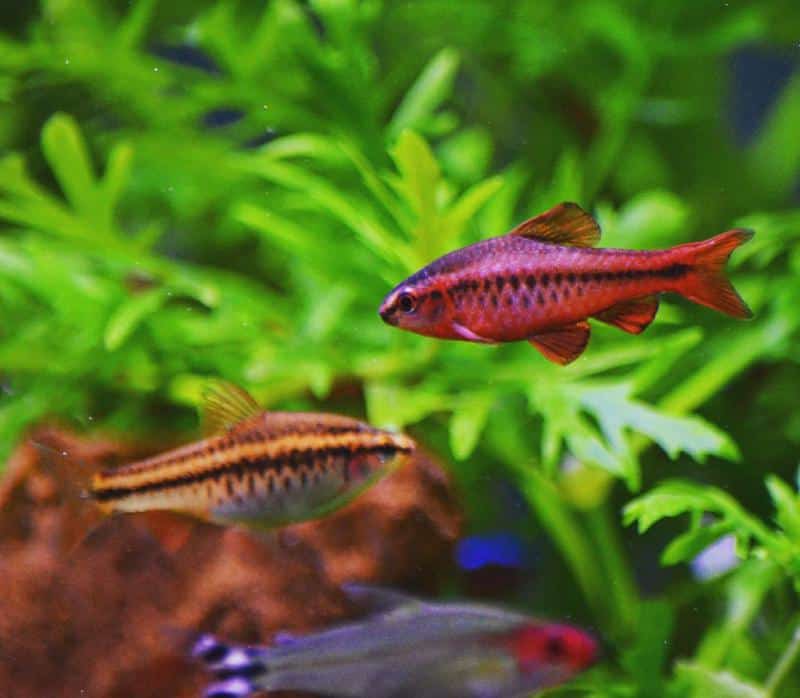
With proper condition and tank setup, Cherry Barbs are one of the many popular fish capable of mating and breeding inside an aquarium.
Setting Up a Breeding Tank
Assuming that you keep your Cherry Barbs in a community tank, you need to set up a separate aquarium and assign it as their breeding tank.
Within the breeding tank, you can prepare for the arrival of your new baby Cherry Barbs by placing a plastic mesh sheet that covers the entire bottom, spawning mops, and live aquarium plants. It is where the eggs will settle down and become their hiding place once hatched.
When it comes to the filtration system of your breeding tank, use a gentle flowing sponge filter. In this way, the eggs will not be sucked when released.
Conditioning a Mating Pair
After setting up, select a mating pair and transfer them to the breeding tank for conditioning by feeding them high-quality foods.
Over the days of conditioning, you will see changes in their bodies where the red coloration in males becomes more intense, and the females develop black vertical stripes. Once you see these body indicators, you can expect courtship to follow shortly.
Courtship Rituals
During courtship, males will try to attract the females by displaying their intense red body coloration and flaring of their fins. It is the only time male Cherry Barbs become aggressive as they swim behind and chase the female to initiate spawning.
This is also the time where selecting a mating pair and transferring them to a breeding tank comes to importance. Imagine if their courtship happens in a community tank. For sure, the aggression of male Cherry Barbs during courtship can escalate to a fight with other males for dominance. Do not worry about the females since they are often calm and submissive.
Induced Spawning
In the wild, Cherry Barbs do not have a specific breeding season. Instead, environmental factors can stimulate breeding, and you can mimic these conditions in your tank.
Temperature is their number one stimulant. By maintaining the water temperature at their upper limit (which is 27 C or 80 F), you are stimulating your mating pair to spawn.
Although not a primary stimulant, consistent lighting schedule could encourage spawning. You can do this by mimicking their natural light cycle which is 12 hours of light exposure and 12 hours of darkness.
Spawning Behavior
Cherry Barbs are oviparous. Once induced to spawn, the females will release their eggs (around 200 to 300) by scattering them on the plants, in the spawning mop, or in the plastic mesh sheet you installed. After which, the males will fertilize the eggs externally.
Parental Removal
Unlike other species of fish which guard their fertilized eggs, parent Cherry Barbs will not do this, and they leave their eggs behind and unattended. The fact is that Cherry Barbs will eat their offspring (both eggs and newly hatched fry).
With this, you should remove the parent Cherry Barb from the breeding tank and place them back in the community tank.
Hatching and Fry Development
Without their parents that could eat them, the fertilized eggs will continue to develop and hatch within 1 to 2 days. After hatching, the fry will remain still and get nutrition initially from their yolk sac.
Two days after hatching, the fry will start moving and eventually become free swimmers. By this time, you need to feed them with microscopic foods (like infusoria and powdered fry food). Do this for a month or until they reach 1 cm long and capable of eating larger foods (like brine shrimps).
Ideal Cherry Barb Tank Mates
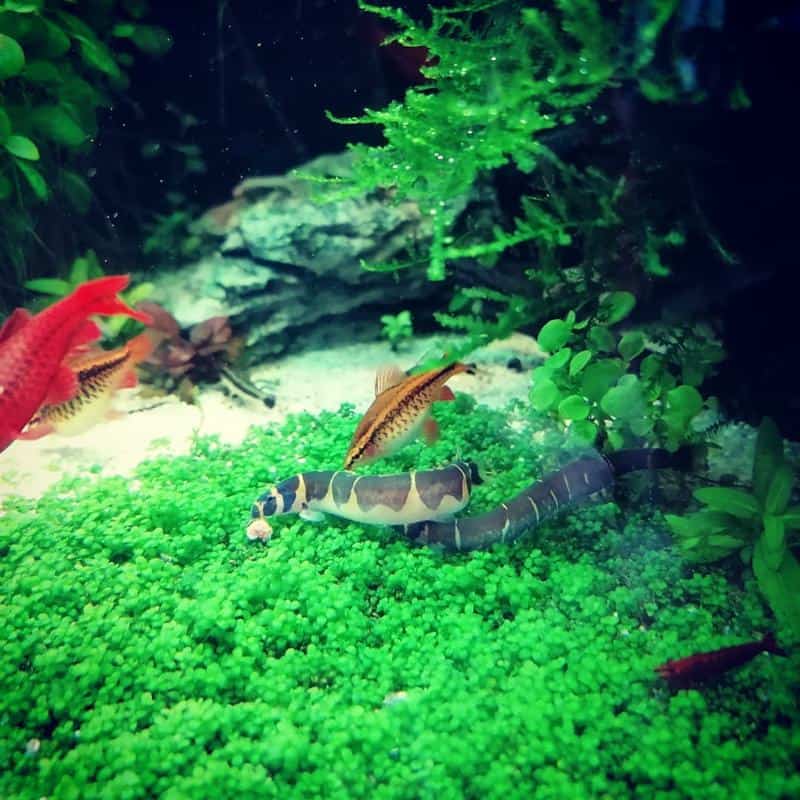
Being great residents of a community aquarium, the tank mates for Cherry Barbs are endless. However, you should consider their tiny size and behavior in selecting their tank mates.
Having similarities in size, peaceful behavior, and thriving with their range of parameters, some of the ideal tank mates for Cherry Barbs include:
- Harlequin Rasbora
- Tetras (like Ember, Neon, Green, and Lemon Tetra)
- Danios (like Zebra and Celestial Pearl Danio)
- Cory Catfish
- Plecos
- Guppies
- Kuhli Loach
- Shrimp (like Dwarf and Amano Shrimp).
Also Read: Ideal Tank Mates for Your Tiger Barb
FAQs
Do Cherry Barbs Eat Hair Algae?
Yes. Cherry Barbs are one of the few species of Cyprinids that will graze on nuisance hair algae. But again, their algae consumption is minimal, and you should never rely on Cherry Barbs as agents in controlling unwanted algae growth.
What Is the Lifespan of Cherry Barbs?
If they are well taken care of, your Cherry Barb can live anywhere from 5 to 7 years.
What Species of Barb Are Not Compatible with Cherry Barbs?
Surprisingly, many Barb species are not compatible with Cherry Barbs. Examples of these are the aggressive fin nippers (like the Tiger, Rosy, and Odessa Barb), territorial (like the Spanner Barb), and large active swimmers (like Tinfoil and Denison Barb).
Final Thoughts
As long as you don’t induce them to breed and spawn, Cherry Barbs will live up to its reputation as being the most peaceful type of Barb fish.
Aside from being hardy and easy to take care of, the bottom line with keeping Cherry Barbs is that this fish will teach you other tank essentials (like how to keep live aquarium plants), which ultimately adds to your experience as an aquarist.
